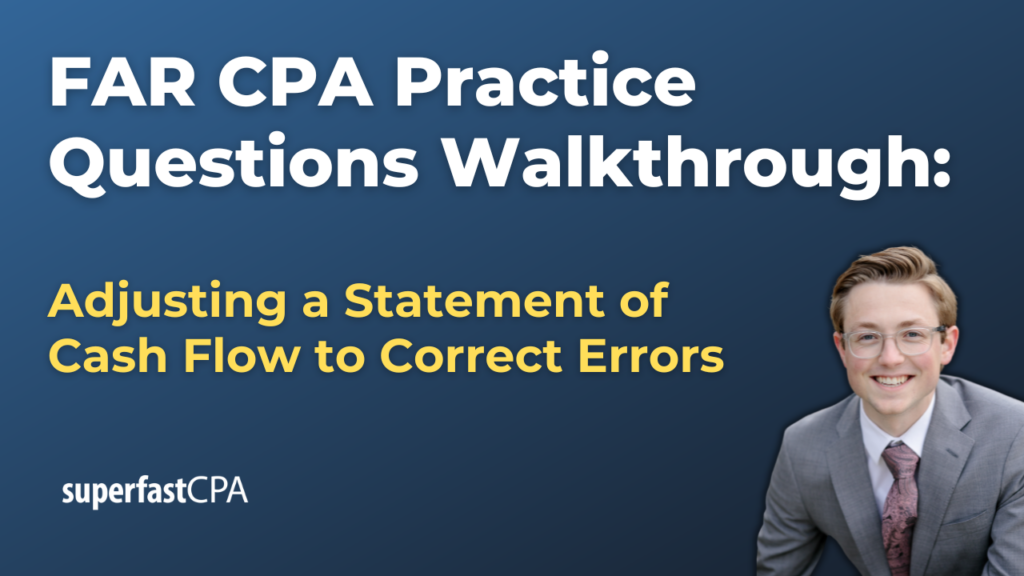In this video, we walk through 5 FAR practice questions teaching about adjusting a statement of cash flow to correct errors. These questions are from FAR content area 1 on the AICPA CPA exam blueprints: Financial Reporting.
The best way to use this video is to pause each time we get to a new question in the video, and then make your own attempt at the question before watching us go through it.
Also be sure to watch one of our free webinars on the 6 “key ingredients” to an extremely effective & efficient CPA study process here…
Adjusting a Statement of Cash Flow to Correct Errors
The statement of cash flow is a crucial financial statement that outlines the cash generated and used during a specific period. It provides insights into a company’s operational efficiency, investment activities, and financial strategies. However, errors can occur in its preparation, particularly when using the indirect method. This overview will discuss common mistakes and how to correct them, ensuring the statement accurately reflects cash movements.
Common Errors in the Statement of Cash Flows
- Misclassification of Activities
- Cash flows must be correctly categorized into operating, investing, and financing activities. Misclassification can lead to inaccurate reporting.
- Error: Including a cash down payment for purchasing equipment under operating activities.
- Correction: Classify it under investing activities, as it involves acquiring long-term assets.
- Double-Counting Adjustments
- The indirect method starts with net income, which includes certain items that should not be adjusted again.
- Error: Adding interest received to operating activities when it is already included in net income.
- Correction: Exclude interest received as it is part of net income unless adjustments are needed for timing differences.
- Handling Non-Cash Transactions
- Non-cash expenses like depreciation and amortization should be added back to net income in operating activities.
- Error: Subtracting depreciation expense in the operating section.
- Correction: Add back depreciation expense as it does not involve an actual cash outflow.
- Incorrect Adjustments for Working Capital Changes
- Changes in working capital accounts must be adjusted correctly to reflect the cash flow.
- Error: Adding an increase in accounts receivable in operating activities.
- Correction: Subtract an increase in accounts receivable, as it represents revenue recognized but not collected in cash.
- Ignoring Non-Cash Gains or Losses
- Gains and losses on sales of assets affect net income but do not directly impact cash flow.
- Error: Adding a gain on the sale of equipment to operating activities.
- Correction: Subtract the gain from operating activities to adjust for its non-cash impact.
- Misclassification of Cash Equivalents
- Transactions involving cash equivalents should not affect the cash flow statement.
- Error: Recording the purchase of treasury bills as an investing cash outflow.
- Correction: Exclude such transactions if they are considered cash equivalents.
Step-by-Step Guide to Correcting Errors
Step 1: Review Initial Classifications
- Operating Activities: Start with net income and adjust for non-cash expenses, non-operating gains/losses, and changes in working capital.
- Investing Activities: Include cash flows from buying/selling long-term assets and other investment activities.
- Financing Activities: Reflect cash flows from changes in equity and debt, such as issuing stock or repaying loans.
Step 2: Identify and Correct Misclassifications
- Carefully check each transaction and ensure it is in the correct category.
- Adjust cash flows accordingly if an activity is wrongly classified.
Step 3: Adjust for Non-Cash Items
- Add back non-cash expenses like depreciation and amortization to net income.
- Correctly adjust for any gains or losses on asset sales to reflect their non-cash nature.
Step 4: Ensure Accuracy in Working Capital Adjustments
- Subtract increases in assets like accounts receivable and inventory.
- Add increases in liabilities like accounts payable and accrued expenses.
Step 5: Review Cash Equivalent Transactions
- Ensure transactions involving cash equivalents are not incorrectly impacting cash flows.
Conclusion
Accurate preparation of the statement of cash flows is essential for providing stakeholders with a clear view of a company’s liquidity and financial health. By understanding common errors and how to correct them, businesses can ensure their cash flow statements are reliable and informative. Remember, the key to a precise cash flow statement lies in the careful classification of activities, avoiding double-counting, and correctly adjusting for non-cash transactions.













